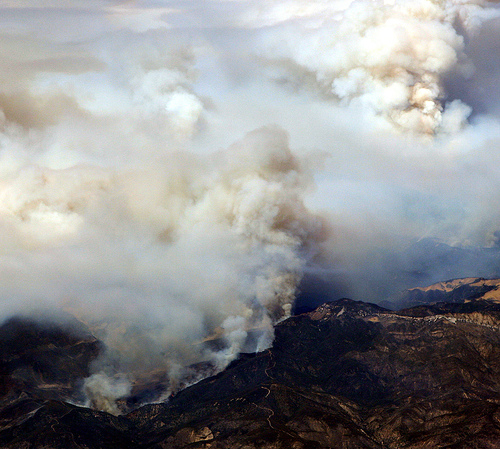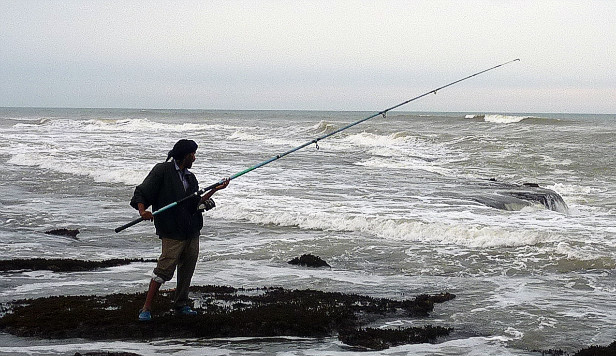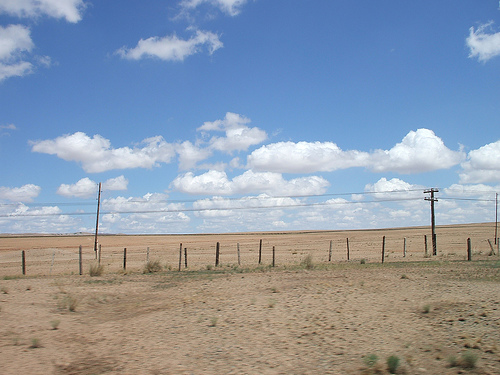desertification
-
EIA projects climate catastrophe
The EIA has projected that the United States will lead the world into catastrophic global warming over the next twenty five years.
-
The rising tide of environmental refugees
Desertification of formerly productive farm land is one of the many reasons for a growing number of environmental refugees around the world.Photo: pizzodisevo via FlickrOur early twenty-first century civilization is being squeezed between advancing deserts and rising seas. Measured by the biologically productive land area that can support human habitation, the earth is shrinking. Mounting […]
-
Morocco’s beaches may become launching point for climate refugees
A Saharawi fisherman on the beach north of Tarfaya in Morocco, just 70km from the Canary Islands.Tim Bromfield Uniformed men patrol the beaches of southern Morocco at night. Their torches are trained on the Atlantic Ocean searching for boats overflowing with economic migrants heading for the Canary Islands. From the beach just north of Tafaya, […]
-
The end of welfare water and the drying of the West
This essay was originally published on TomDispatch and is republished here with Tom’s kind permission. Pink snow is turning red in Colorado. Here on the Great American Desert — specifically Utah’s slickrock portion of it where I live — hot ‘n’ dry means dust. When frequent high winds sweep across our increasingly arid landscape, redrock […]
-
Does Sen. Feinstein get global warming, desertification, and California’s looming demise?
Senator Dianne Feinstein (D-CA) appears to like deserts so much that she wants them to stretch from Oklahoma to California and cover one third the planet. The AP reported Friday, “Feinstein seeks [to] block solar power from desert land“: Nineteen companies have submitted applications to build solar or wind facilities on a parcel of 500,000 […]
-
What does economic 'recovery' mean on an extreme weather planet?
This is a guest essay by Tom Engelhardt, co-founder of the American Empire Project and an editor of the Nation Institute's TomDispatch.com. Englehardt is also the author of The End of Victory Culture and the editor of The World According to TomDispatch: America in the New Age of Empire. This post was originally published on TomDispatch and is republished here with Tom's kind permission.
-----
It turns out that you don't want to be a former city dweller in rural parts of southernmost Australia, a stalk of wheat in China or Iraq, a soybean in Argentina, an almond or grape in northern California, a cow in Texas, or almost anything in parts of east Africa right now. Let me explain.
As anyone who has turned on the prime-time TV news these last weeks knows, southeastern Australia has been burning up. It's already dry climate has been growing ever hotter. "The great drying," Australian environmental scientist Tim Flannery calls it. At its epicenter, Melbourne recorded its hottest day ever this month at a sweltering 115.5 degrees, while temperatures soared even higher in the surrounding countryside. After more than a decade of drought, followed by the lowest rainfall on record, the eucalyptus forests are now burning. To be exact, they are now pouring vast quantities of stored carbon dioxide, the greenhouse gas considered largely responsible for global warming, into the atmosphere.
In fact, everything's been burning there. Huge sheets of flame, possibly aided and abetted by arsonists, tore through whole towns. More than 180 people are dead and thousands homeless. Flannery, who has written eloquently about global warming, drove through the fire belt, and reported:
-
CNN, ABC, WashPost, and AP blow Australian wildfire, drought, heat-wave story
If the U.S. media refuse to make the connection between record breaking wildfire, drought, and heat waves and human-caused global warming, why would anyone be surprised if the U.S. public doesn't put it as a higher priority or make the connection itself (see here)?
Australia knows it's facing climate-driven impacts that threaten it with complete collapse (see here). AFP (French international media) get this: "Australian wildfire ferocity linked to climate change: experts." So does Reuter's climate change correspondent in Asia: "Australia fires a climate wake-up call: experts."
I saw the CNN and ABC stories, and you can read the AP's stories, which have been published in the Washington Post and NY Times (though the NYT redeemed itself, see below). The media love a good calamity of Biblical proportion:
-
'We're looking at a scenario where there's no more agriculture in California,' Part 2
Finally, we have a top administration official telling it like it is. Energy Secretary and Nobelist Steven Chu told a Los Angeles Times reporter:
In a worst case, Chu said, up to 90% of the Sierra snowpack could disappear, all but eliminating a natural storage system for water vital to agriculture.
"I don't think the American public has gripped in its gut what could happen," he said.Precisely. [You can listen to an interview with the LAT reporter and me on To the Point here.]
We face desertification of perhaps a third of the earth that is "largely irreversible for 1,000 years" -- if homo sapiens are not sapiens enough to sharply and quickly reverse emissions trends. Part 1 looked at the canary-in-the-coal mine for desertification: "Australia faces collapse as climate change kicks in."
But the Southwest from Kansas and Oklahoma to California are right behind Australia, according to a 2007 Science ($ub. req'd) paper:
Here we show that there is a broad consensus among climate models that this region will dry in the 21st century and that the transition to a more arid climate should already be under way. If these models are correct, the levels of aridity of the recent multiyear drought or the Dust Bowl and the 1950s droughts will become the new climatology of the American Southwest within a time frame of years to decades.
[Note: That study "only" modeled the A1B emissions scenario, which leads to 720 ppm by 2100. We are currently on track to 1,000 ppm (see here).]
A December U.S. Geological Survey report also warned that the Southwest faces "permanent drying" by 2050.
Before the permanent drying -- aka a desert -- sets in, you'd expect to see more and longer record-breaking droughts. In fact, Lester Snow, director of California's Department of Water Resources said Friday:
-
Australia faces collapse as climate change kicks in
Australia has been suffering its worst heat wave on record, the first time temperatures exceeded 110 degrees Fahrenheit for three days running. It's been so hot that on Thursday, the low at Melbourne airport was 87 °F.
Australia is the canary in the coal mine for climate-driven desertification. The astonishing decade-long drought in southern Australia was declared 'worst on record' last year. The U.K.'s Independent notes:
Australia, the driest inhabited continent on earth, is regarded as highly vulnerable. A study by the country's blue-chip Commonwealth Scientific and Industrial Research Organisation identified its ecosystems as "potentially the most fragile" on earth in the face of the threat.
Australia is but the first and most seriously impacted of the arid sub-tropical (and near-sub-tropical) climates that are facing horrific desertification from climate change. For instance, Lester Snow, director of California's Department of Water Resources said Friday:
We may be at the start of the worst California drought in modern history.
Two years ago, Science ($ub. req'd) published research that "predicted a permanent drought by 2050 throughout the Southwest" -- levels of aridity comparable to the 1930s Dust Bowl would stretch from Kansas to California. The U.K.'s Hadley Center warned in November 2006 that their research predicted multiple permanent Dust Bowls around the planet on our current emissions path:




